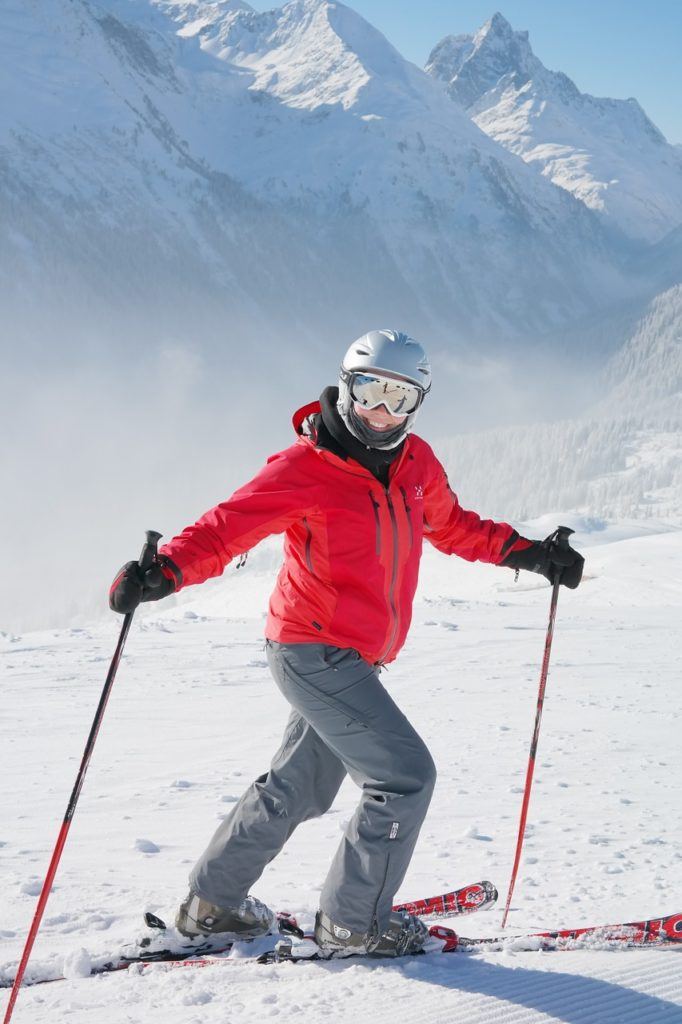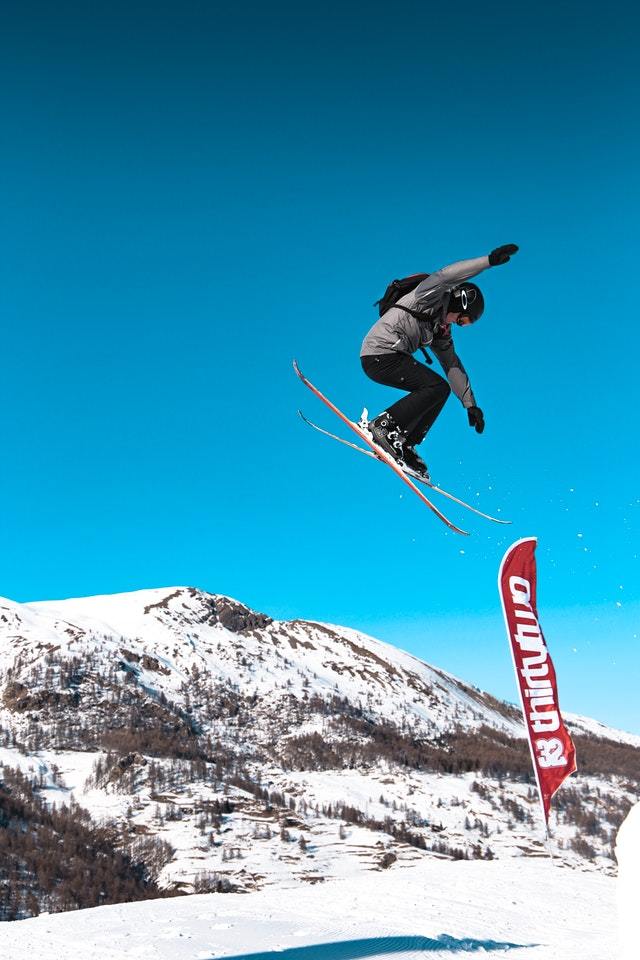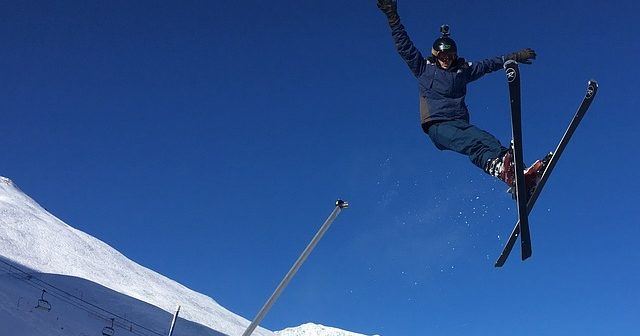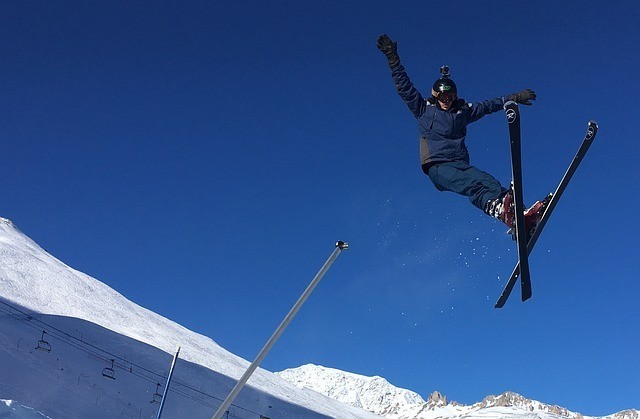If you’re ready to take your skiing skills to the next level, then freestyle skiing may be right up your alley.
However, you do need to be somewhat experienced before you try pulling off any complicated ski jump moves.
Let’s take a look at how advanced you need to be to start freestyling, what equipment you should invest in, what terrain is best for this style of skiing, and how you can perform some beginner snow ski tricks on the slopes.
With the right know-how, you’ll be pulling off sick moves in no time.
Contents
How Advanced Do You Need to Be for Ski Tricks?
Freestyle tricks may seem nearly impossible to do at first, but once you get the hang of some basic ski jump techniques, you’ll be pulling them off with ease.
Springing
Springing is a fairly simple move. You bend your knees to bring your body as low to the ground as possible, then spring back up and fully extend your body when you come close to the jump point.
Your crouching gives you enough momentum to launch yourself in the air.
Once you’re airborne, tuck your knees to your chest, so you have better balance when you land.
The Ollie
The ollie is a more challenging move, but once you pull it off, you can really maximize your air time, jump height, and distance.
First, you lean forward to anticipate the jump. Next, throw your full weight backwards, forcing the back of the skis to bend while your front tips rise from the ground.
As your front tips rise, gently push your weight forward again and use the sudden spring to catapult yourself into the air. Make sure you always tuck your body to keep your balance when you land.
While these ski jump moves may sound incredibly simple, they can be very difficult for novice freestylers to pick up at first. As it turns out, the hardest part of any ski trick is the initial jump.
This is why it’s so crucial for you to master these moves before you even attempt any beginner snow ski tricks, like aerial tricks or moving on to rails, halfpipes, and other freestyle courses.
What Equipment Do You Need?
Freestyle skiing requires you to gain as much height as possible to perform certain tricks. With that in mind, some of the more advanced moves can’t even be pulled off unless you have the right gear.

Bindings
Your binding should be strapped parallel to the direction of the run. About 57 percent of your entire skis’ length should be used as the front part in this way.
Ski Jumping Suit
All parts of your ski jumping suit should be made of the same kind of air permeable material.
The thicker the suit, the better, since you may be out on the slopes perfecting your tricks for a while.
Boots
Your ski boots should be flexible, so you can lean forward and do your jumps easily. Being weighed down will hinder your progress.
Even further, a good pair of boots should have a low cut at the front and a high back to protect your feet from the chilly snow.
Jumping Skis
These are the most crucial component of any freestyle skiing inventory because they are specifically designed to help you pull off some sweet ski tricks on the slopes.
The overall shaping and curvature of the ski need to be measured against your own physiology. No two sets of jumping skis are the same, because they are tailored specifically to their rider’s height and weight.
The ski itself can be as long as 146 percent of your total height. To a novice, knowing which kind of ski you should practice on can be quite confusing.
For simplicity’s sake, look into which of these three categories you’d like to try out first:
- Jibs.
- Jumps.
- Both.
If you want to try out other types, however, feel free to do so!

Jibs
If you want a playful kind of ski that can smear through turns, spin easily, and glide cleanly across the mountain slopes, then you may want to use a jib ski.
Jibs have a soft flex rating, meaning they have a gentle, buttery core that allows your skis to easily bend, smear your turns, butter those knuckles, and pull off style-heavy presses on boxes and rails.
They also have a rockered profile, which allows for all that effortless maneuverability and a lowered risk of your tip or tail snagging on the terrain.
Jibs can be average-sized or a little on the wider side. A semi-wide platform will provide extra stability and have a more surf-like feel. However, you may choose a more average-sized ski based on your personal preferences.
Compared to other types of all-mountain skis, jibs are slightly shorter than the rest. However, this shorter length increases your maneuverability and lessens your swing weight when you do a spin or flip.
Here’s a video with more details on jibbing.
Jumps
Unfortunately, soft, fully rockered skis aren’t the best to use at fast speeds. Skiers who want to try out the halfpipe or the proline jumps (or those who have a bigger need for speed than others) will find that skis made specifically for jumps work best for them.
Jump skis have a stiffer flex rating. This means that they offer better edging and stability for jumps and thrilling high-speed landings. Big air skiers will definitely appreciate that.
A fully cambered profile will offer you the most reliable jumps (or pops), as well as precision aiming. This serves you well as you build up to tricks and jumps on the more groomed slopes or park terrains.
These skis tend to veer toward the narrower end, with the average size being the thickest allowed. This is because the thinner width allows you more precision and control while you carve into and off of jumps. It also offers a stronger edge hold as you land.
To pull off a wicked jump, it’s best you keep to the more typical all-mountain ski lengths. Shorter skis are far too unstable for speedy landings, and longer skis will give you excessive swing weight during in-air maneuvers.
Both
If you want to try every kind of attraction the ski park has to offer – especially as a beginning freestyle skier – then you’ll need a more diverse ski that blends the best of both a jib and a jump ski.
First, look for a ski that has a moderate flex. These skis give solid performances on jumps, rails, and boxes, and are more forgiving of novices trying to stick bigger landings.
You’ll also want a hybrid rocker style ski, specifically a rocker/camber/rocker combination. The rockers in the tip and tail allow you to initiate turns easier, while also lowering the chances of snagging them on any rails.
The underfoot camber will also give you the right amount of pop on jumps, along with some sweet carving.
Just like a jib ski, it’s best to get a set that’s an average to semi-wide length. This way, they’re wide enough to help keep you stable but narrow enough to allow for carving.
The length of your skis will depend on your own personal preference. Shorter skis will spin easier, of course, but slightly longer skis will give you better stability on your landings.
What Terrain is Best for Ski Tricks?
Ultimately, when choosing the right terrain to practice on, it’s best to follow S.M.A.R.T.

Start Small
Always practice building up your skiing abilities before slowly working your way up to more complicated terrains and ski tricks.
Make a Plan
Planning what areas of the ski park you intend to hit beforehand will help you keep on top of your skiing progress.
Always Look
Downhill skiers always have the right-of-way in the park, but some careless person may not look before leaping.
It is always wise to look up to make sure no one drops down on top of you before you drop yourself. Similarly, you should always look down before dropping, too.
Respect
Remember that you don’t own the mountain! Give way to other skiers and snowboarders, and they will do the same for you.
Take It Easy
You might be eager to push yourself to your absolute limits on the slopes, but remember to take breaks every now and then. You’re still a beginner, after all.
Best Ski Tricks for Beginners
Air to Fakie
An Air to Fakie is basically a 180-degree turn in the air that ends with you riding backwards after landing.
First, make sure to glide downhill at a moderate speed. To initiate the turn, twist your body in the direction you want to spin. Then, crouch down and shift your weight to your back foot.
Lift the tip of your skis and then the tail. Once you’re airborne, turn 180 degrees and prepare yourself to land. Both your feet should hit the snow at the same time, with your body crouched to reduce the force of impact. You can then “ride the fakie” out until you stop.
Be sure to start slow on this one, as the landing is more complicated than with other tricks.

Kangaroo Flip
The kangaroo flip first became famous back in 2006 when Jon Olsson, an Australian skier, first invented it. Since then, however, the trick has become overused in skiing competitions to the point where it’s become boring.
That’s not to say that this trick is a basic one, by any means. It still takes a rather skilled skier to pull it off well.
Though many skiers can’t seem to agree on how to pull off the right style of kangaroo flip, the most popular consensus is that it’s a flat spin 5 to flat spin 3.
Cab 1440 Mute
This ski trick is still a hot topic in the more famous side of freestyle skiing. This is because many skiers claim that simply spinning around in the air a bunch of times has a distinct lack of style; it’s instead a subpar method of showing off your skills.
The key to giving this trick more flair is the cab, or going off switch 1440 – giving you four, full, stylish spins. Henrik Harlaut is thought to be the first one to accomplish it, but T.J. Schiller has pretty much perfected this trick.
In fact, when he first pulled it off, he bet Jon Olsson $1,000 that he could never do it again. Fortunately (or unfortunately, depending on who you define as the winner), he was able to pull off this sweet move over and over again.
Cab 5 Double Grab
While some people think quickly spinning to win competitions seals the deal, others will vehemently defend the slower, more technical tricks to the death.
This double grab ski trick is said to be one of the best slower tricks to have ever been pulled off by a professional skier.
Pistol Flip
Inverted tricks are amazing because they can be so hard to pull off successfully.
Joe Murrell, an English kid who apparently did only one season of skiing before inventing this trick, has been hailed as a skiing legend because of it.
Basically, this trick is a bio 7 to misty 5.
D.J. Flip
This is the second double flip trick invented by Jon Olsson (with the kangaroo flip being the first), hence the name the Double Jon Flip – or D.J. Flip for short.
One of the weirder trends about Jon’s tricks? Skiers can’t seem to agree on how to accurately pull them off in the air. Again, the most popular opinion is that it might be a very complicated-sounding d-spin 630 to flat spin 630.
This video goes into more detail on ski tricks.
Conclusion
Delving into freestyle skiing headfirst can be quite daunting. However, now that you know how to do some easy ski tricks, you can impress everyone at the park with your amazing skills.
Just remember to gather up the right equipment, find skis suited for your unique style, and always stay S.M.A.R.T. on the trails. With that accomplished, you should be good to go.
What are your favorite ski tricks?





